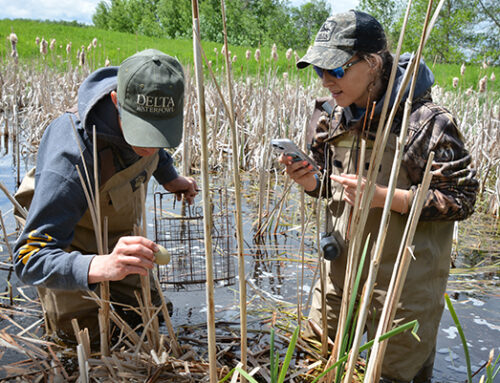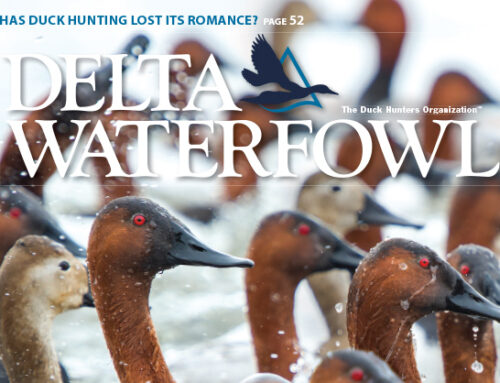Mallards Increase in California, Wisconsin and Minnesota

With the season just weeks away, waterfowlers everywhere are anticipating release of the 2018 USFWS Waterfowl Breeding Duck Population and Habitat Survey, expected next month. The report is a key predictor of the size of the fall flight, and will be used to determine bag limits and season lengths for the 2019-2020 waterfowl season.
In the meantime, state breeding duck population surveys offer a glimpse at what we could see when the USFWS survey is released.
As previously reported by Delta Waterfowl, North Dakota’s survey showed an index of 2.8 million ducks, a decline of 4.9 percent from 2017. Despite a fourth straight drop, the count remains 16 percent above the long-term average (1948 to 2017) and mallards remain stable, declining just 1.4 percent. The wetland index declined 34.1 percent from last year, and sits 29 percent below the long-term average. Although dry conditions likely hampered production, rain brought more favorable conditions for raising broods in June and early July.
More recently released surveys offer greater optimism, especially if you’re a fan of mallards. Greenheads are on the rise in California, Minnesota and Wisconsin.
California
Golden State waterfowl show strong signs of recovery following a 2013 to 2016 drought that dramatically impacted production. The state’s total breeding duck population estimate of 549,180 is a 39 percent increase over 2017 and just 0.4 percent below the long-term average. Mallards, gadwalls and cinnamon teal comprised 83 percent of the estimate.
Mallards increased 38 percent to a breeding population estimate of 272,859, but remain 19 percent below the long-term average. Notable population increases were observed in key regions such as the Sacramento Valley (up 83 percent from a record low in 2017) and the San Joaquin Grasslands (up 73 percent). Mallard estimates exceed long-term averages in Northeastern California, at 19 percent above, and Napa-Santa Rosa, 27 percent above.
Gadwalls increased 43 percent, putting them 20 percent above the long-term average. Cinnamon teal are up a sizable 131 percent, and are now 83 percent above the long-term average.
Strong increases were also observed among wood ducks (up a whopping 667 percent), northern shovelers, redheads and canvasbacks.
Unfortunately, after a strong increase in 2017, pintails declined 63 percent to an estimate of 8,478 ducks, but remain 19 percent above the long-term average. Wigeon, lesser scaup, ring-necked ducks, ruddy ducks and mergansers also declined.
California’s Canada goose estimate of 54,851 is a minimal 0.7 percent decline, but still 26 percent above the long-term average.
Minnesota
Minnesota’s state survey estimates a total duck abundance, excluding bluebills, of 693,000, which is 9 percent higher than 2017, and 12 percent above the long-term average. The jump largely owes to increases among mallards and blue-winged teal.
The mallard breeding population was estimated at 295,000, 38 percent above last year’s estimate and 30 percent above the long-term average. The blue-winged teal population estimate is 191,000, which is 20 percent above 2017 and settles 10 percent below the long-term average.
Canada geese also increased, jumping 7 percent to 162,286 birds, 2 percent above the long term-average.
Other species showed declines. Bluebills dropped 59 percent to 31,490, 48 percent below the long-term average. The combined populations of other ducks, including ring-necked ducks, wood ducks, gadwalls, shovelers, canvasbacks and redheads, is 207,000, is 21 percent lower than 2017, but remains 15 percent above the long-term average.
Breeding conditions were stable in Minnesota this year. An estimated pond count of 263,000 is 1 percent lower than 2017, but 4 percent above the long-term average.
Wisconsin
Wisconsin’s state survey showed an index of 439,397 ducks, an 8 percent decrease over 2017, but equal to the long-term average.
Of Wisconsin’s three species-specific estimates, only mallards increased, climbing 20 percent to 216,652 ducks, 19 percent above the long-term average. That’s significant news for Badger State waterfowlers, as roughly 70 percent of Wisconsin’s mallard harvest consists of locally produced ducks. A stable wood duck population declined 2 percent to 100,055 birds, remaining 24 percent above the long-term average. Blue-winged teal dropped 47 percent to 45,130, which is 58 percent below the long-term average.
The estimate for other ducks — common goldeneyes, ring-necked ducks, green-winged teal, pintails, shovelers and more — was 77,560, representing a 30 percent decline, but still 19 percent above the long-term average.
A Canada goose estimate of 157,950 is statistically unchanged from 2017, remaining 61 percent above the long-term average.
The survey found average to above-average wetland conditions in May, and considerable rains have fallen since. Therefore, the state is expected to provide good duck production in 2018.
What will be revealed by the USFWS duck survey? Stay tuned to DeltaWaterfowl.org and Delta’s social media channels — Facebook, Instagram and Twitter — for breaking news and expert analysis of survey results.






Leave A Comment